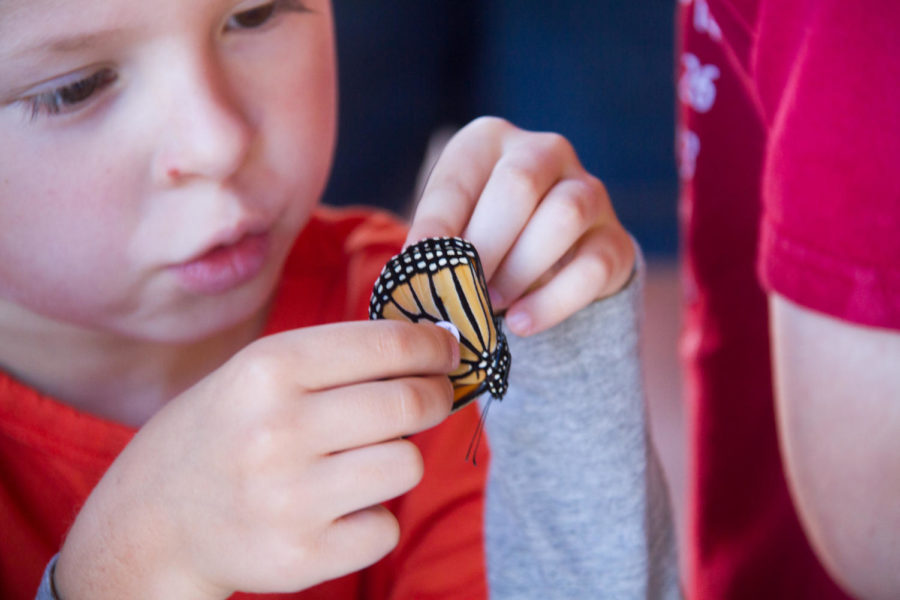Iowa Monarch Conservation Consortium aims to restore eastern monarch butterfly status
A child puts a sticker on a butterfly as part of a Monarch tagging event, Sept. 11, 2016 at Reiman Gardens. After the butterflies were tagged, they were released into the wild, where they could start their journey south to Mexico for the winter.
February 13, 2017
The eastern monarch butterfly is almost extinct, and scientists say humans are to blame. A group of people at Iowa State is aiming to change all of that.
The goal of the Iowa Monarch Conservation Consortium, a research center on campus, is to increase the eastern monarch butterfly population. According to the consortium, the population reached an all-time low in 2014, covering only 1.66 acres of forest when they migrated to Mexico. This puts them on the brink of extinction.
With their bright orange, black and white wings, they are seen all over Iowa during warm months. Each spring, they travel more than 2,000 miles from Mexico to lay eggs.
But monarchs are unique in that the caterpillars require the milkweed plant to survive. Female butterflies will only lay their eggs on milkweed, and it’s getting harder to find each year.
“We need about 1.6 billion milkweed stems to get the [monarch] population back to a reasonable level,” said John Pleasants, assistant professor who has studied the effect herbicides have on the monarch population.
Fifty percent of the fields in Iowa contained common milkweed in 1999, Pleasants said. For a female monarch butterfly, finding a place to lay her eggs would have been easy back then.
More recently, a new survey conducted by the Iowa Monarch Conservation Consortium in 2015 discovered that there are no more fields left in Iowa with the plant. Milkweed is now only found along roadsides.
“We’ve got this fragmented landscape,” Pleasants said. “The milkweeds are just scattered … and not as abundant as they were before. What that means is that a female just has to really work. At some point she’s going to [die] and not lay all the eggs she could lay.”
The desire to keep a piece of land looking free of weeds is causing the decline in the eastern monarch population, Pleasants said. Land owners will use lawnmowers and chemicals to kill weeds, preventing growth of new milkweed along roadsides.
The consortium is working with land owners all over Iowa to allow milkweed and other diverse plants to grow in crop land that is no longer in production.
But Bob Hartzler, a weed scientist at Iowa State, said a new invasive weed called Palmer amaranth is scaring farmers from doing this.
“It has the potential to persuade farmers that diversity is bad,” Hartzler said.
Hartzler explained that they are trying to work with farmers to allow diversity in their fields without the threat of Palmer amaranth.
Insecticides are to blame for monarch population decline as well. Chemicals used on crops to prevent or kill crop-damaging insects are used all over Iowa. Niranjana Krishnan, graduate student studying toxicology and entomology, said these insecticides can land on milkweed and kill caterpillars or prevent them from growing up healthy enough to migrate to Mexico.
“A lot of roadsides aren’t that far away from farm fields in Iowa,” Krishnan said. “If you spray an insecticide [on the field], you could have the [insecticide] drift … landing on the milkweed plants.”
To help encourage monarch populations to grow, Victoria Pocius, graduate student in conservation biology, is currently studying which species of milkweed female monarchs prefer.
She said Iowa is a vital place to increase eastern monarch populations because a majority of the butterflies are coming from the Midwest.
“If we have to get a billion plants on the ground, you want to make sure you’re planting things that will grow well [in Iowa],” Pocius said. “Also, you want want to make sure the butterflies use them.”
The population is steadily rising, but not as much as the researchers want. The official 2017 monarch butterfly population now covers 7.2 acres of forest in Mexico, according to the Iowa Monarch Conservation Consortium.
To these scientists, they aren’t just saving an entire species, they’re saving a major icon in North American culture. The monarch has touched the lives of many people, and that’s what drives the consortium team.
“Whether is was a little kid holding a butterfly for the first time or whether it was someone that grew up watching them, they all have a personal connection to that butterfly,” Pocius said. “Having a butterfly in your hand and remembering what that means to you, I think really hits home for a lot of people.”
















